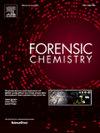Quantitative analysis of cannabinoids by zone heat-assisted DART-MS with in-situ flash derivatization
IF 2.6
3区 医学
Q2 CHEMISTRY, ANALYTICAL
引用次数: 0
Abstract
Accurate quantitation of cannabinoids, particularly Δ9-tetrahydrocannabinol (THC) and cannabidiol (CBD), is essential for regulatory compliance, forensic investigations, and cannabis product development. Traditional methods, such as liquid chromatography (LC) and gas chromatography (GC) coupled with mass spectrometry, provide reliable results but are time-consuming and resource-intensive. This study introduces a rapid and high-throughput analytical method using zone heat-assisted direct analysis in real time mass spectrometry (DART-MS) combined with in-situ flash derivatization. The method employs trimethylphenylammonium hydroxide (TMPAH) for efficient derivatization, allowing for the differentiation of THC, CBD, and their acidic precursors, Δ9-tetrahydrocannabinolic acid (THCA) and cannabidiolic acid (CBDA). A custom heated transfer zone was implemented to enhance derivatization efficiency and reduce carryover effects. The method was optimized for reagent concentration and gas stream temperature, achieving high specificity by minimizing interference from isomeric cannabinoids. Validation studies demonstrate good accuracy (relative error within ±15.9 %) and precision (relative standard deviation ≤15 %), with limits of quantitation of 7.5 µg/mL for THC/CBD and 0.5 µg/mL for THCA/CBDA. Comparative analysis of cannabis samples showed a strong correlation with reference LC/MS results, highlighting the reliability of the proposed method. DART-MS offers a significant time advantage, requiring only 10 s per analysis, making it a promising tool for high-throughput screening of cannabis samples in forensic laboratories.

区域热辅助DART-MS原位闪蒸衍生定量分析大麻素
大麻素的准确定量,特别是Δ9-tetrahydrocannabinol (THC)和大麻二酚(CBD),对于监管合规、法医调查和大麻产品开发至关重要。传统的方法,如液相色谱(LC)和气相色谱(GC)结合质谱法,可以提供可靠的结果,但耗时且资源密集。本研究介绍了一种快速、高通量的分析方法,使用区域热辅助实时质谱直接分析(DART-MS)结合原位闪蒸衍生。该方法采用三甲基苯基氢氧化铵(TMPAH)进行高效衍生化,允许THC, CBD及其酸性前体Δ9-tetrahydrocannabinolic酸(THCA)和大麻二酚酸(CBDA)的分化。采用定制的加热转移区,以提高衍生化效率,减少结转效应。该方法对试剂浓度和气流温度进行了优化,最大限度地减少了同分异构体大麻素的干扰,达到了高特异性。验证研究表明具有良好的准确度(相对误差在±15.9%以内)和精密度(相对标准偏差≤15%),THC/CBD的定量限为7.5µg/mL, THCA/CBDA的定量限为0.5µg/mL。大麻样品的对比分析结果与参考LC/MS结果具有较强的相关性,突出了所提方法的可靠性。DART-MS具有显著的时间优势,每次分析只需要10秒,使其成为法医实验室高通量筛选大麻样本的有前途的工具。
本文章由计算机程序翻译,如有差异,请以英文原文为准。
求助全文
约1分钟内获得全文
求助全文
来源期刊

Forensic Chemistry
CHEMISTRY, ANALYTICAL-
CiteScore
5.70
自引率
14.80%
发文量
65
审稿时长
46 days
期刊介绍:
Forensic Chemistry publishes high quality manuscripts focusing on the theory, research and application of any chemical science to forensic analysis. The scope of the journal includes fundamental advancements that result in a better understanding of the evidentiary significance derived from the physical and chemical analysis of materials. The scope of Forensic Chemistry will also include the application and or development of any molecular and atomic spectrochemical technique, electrochemical techniques, sensors, surface characterization techniques, mass spectrometry, nuclear magnetic resonance, chemometrics and statistics, and separation sciences (e.g. chromatography) that provide insight into the forensic analysis of materials. Evidential topics of interest to the journal include, but are not limited to, fingerprint analysis, drug analysis, ignitable liquid residue analysis, explosives detection and analysis, the characterization and comparison of trace evidence (glass, fibers, paints and polymers, tapes, soils and other materials), ink and paper analysis, gunshot residue analysis, synthetic pathways for drugs, toxicology and the analysis and chemistry associated with the components of fingermarks. The journal is particularly interested in receiving manuscripts that report advances in the forensic interpretation of chemical evidence. Technology Readiness Level: When submitting an article to Forensic Chemistry, all authors will be asked to self-assign a Technology Readiness Level (TRL) to their article. The purpose of the TRL system is to help readers understand the level of maturity of an idea or method, to help track the evolution of readiness of a given technique or method, and to help filter published articles by the expected ease of implementation in an operation setting within a crime lab.
 求助内容:
求助内容: 应助结果提醒方式:
应助结果提醒方式:


